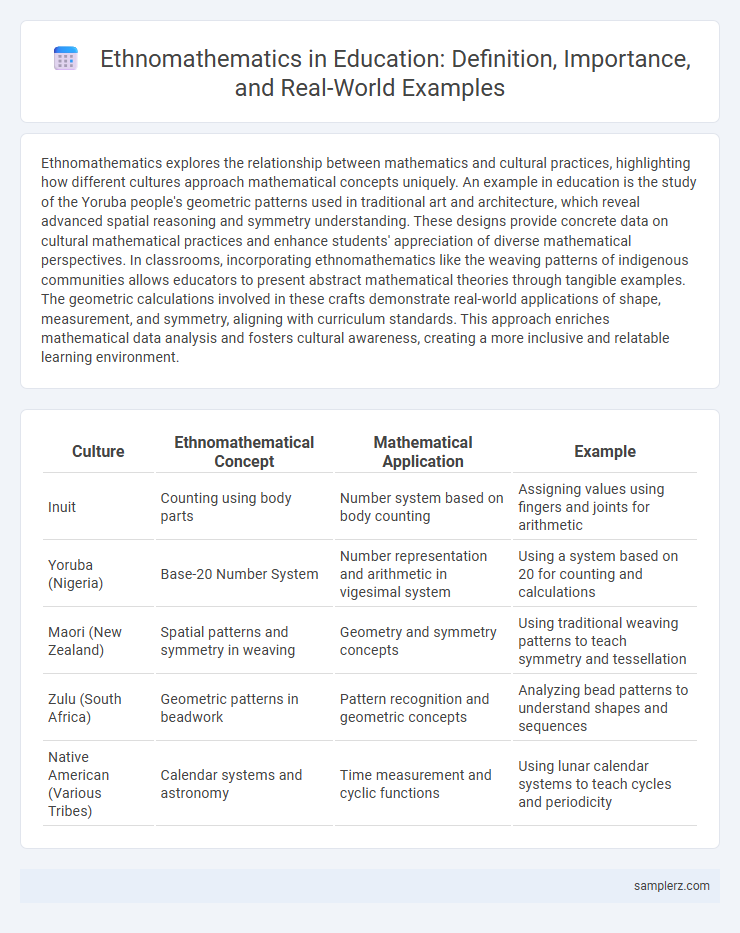Ethnomathematics explores the relationship between mathematics and cultural practices, highlighting how different cultures approach mathematical concepts uniquely. An example in education is the study of the Yoruba people's geometric patterns used in traditional art and architecture, which reveal advanced spatial reasoning and symmetry understanding. These designs provide concrete data on cultural mathematical practices and enhance students' appreciation of diverse mathematical perspectives. In classrooms, incorporating ethnomathematics like the weaving patterns of indigenous communities allows educators to present abstract mathematical theories through tangible examples. The geometric calculations involved in these crafts demonstrate real-world applications of shape, measurement, and symmetry, aligning with curriculum standards. This approach enriches mathematical data analysis and fosters cultural awareness, creating a more inclusive and relatable learning environment.
Table of Comparison
| Culture | Ethnomathematical Concept | Mathematical Application | Example |
|---|---|---|---|
| Inuit | Counting using body parts | Number system based on body counting | Assigning values using fingers and joints for arithmetic |
| Yoruba (Nigeria) | Base-20 Number System | Number representation and arithmetic in vigesimal system | Using a system based on 20 for counting and calculations |
| Maori (New Zealand) | Spatial patterns and symmetry in weaving | Geometry and symmetry concepts | Using traditional weaving patterns to teach symmetry and tessellation |
| Zulu (South Africa) | Geometric patterns in beadwork | Pattern recognition and geometric concepts | Analyzing bead patterns to understand shapes and sequences |
| Native American (Various Tribes) | Calendar systems and astronomy | Time measurement and cyclic functions | Using lunar calendar systems to teach cycles and periodicity |
Integrating Indigenous Counting Systems in Modern Classrooms
Integrating Indigenous counting systems such as the Yupno's spatial counting or the Oksapmin's body-tally technique enriches mathematical understanding by connecting cultural context with numerical concepts. These ethnomathematics examples demonstrate alternative base systems and spatial reasoning, promoting cognitive diversity and inclusivity in education. Modern classrooms benefit from incorporating these methods, enhancing students' engagement and critical thinking about number systems beyond conventional Western arithmetic.
Ethnomathematics in African Fractals and Architecture
Ethnomathematics in African fractals and architecture reveals complex geometric patterns embedded in cultural artifacts, such as the recursive designs found in village layouts and woven textiles. These fractal structures demonstrate sophisticated mathematical concepts like self-similarity and scaling, essential for spatial organization and aesthetic harmony. Understanding African fractals enriches mathematical education by integrating indigenous knowledge systems and highlighting the interplay between culture and quantitative reasoning.
Traditional Weaving Patterns as Mathematical Concepts
Traditional weaving patterns from cultures such as the Navajo, Ashanti, and Indonesian communities showcase intricate geometric shapes that embody principles of symmetry, tessellation, and fractal design. These patterns serve as practical illustrations of mathematical concepts like algorithmic repetition, spatial reasoning, and modular arithmetic. Integrating ethnomathematics into education highlights the cultural relevance of mathematics and enriches students' understanding through diverse mathematical traditions.
Aboriginal Measurement Systems in Geometry Lessons
Aboriginal measurement systems use natural landmarks and body-based units, such as the foot or arm span, to teach geometric concepts, offering practical and culturally relevant examples in classroom settings. These systems emphasize spatial awareness and pattern recognition drawn from Indigenous territories, enriching students' understanding of geometry through real-world applications. Incorporating ethnomathematics in lessons promotes inclusivity and connects mathematical principles to diverse cultural traditions.
Native American Symbolism and Mathematical Logic
Native American symbolism in ethnomathematics demonstrates the use of geometric patterns and spatial reasoning deeply embedded in cultural artifacts such as pottery and textiles, illustrating advanced mathematical logic. These patterns often incorporate symmetry, fractals, and binary structures, reflecting sophisticated forms of abstraction and problem-solving. The study of such symbolism reveals alternative mathematical frameworks that enrich the understanding of logic beyond Western paradigms.
Brazilian Street Mathematics: Learning from Everyday Practices
Brazilian Street Mathematics exemplifies ethnomathematics by integrating everyday practices, such as market trading and informal measuring methods, into formal mathematics education. This approach highlights how local knowledge and cultural context influence mathematical reasoning and problem-solving. Incorporating these real-life examples enhances student engagement and deepens understanding of mathematical concepts through culturally relevant experiences.
Polynesian Navigation and Applied Geometry
Polynesian navigation exemplifies ethnomathematics through the use of applied geometry in wayfinding, relying on star paths, wave patterns, and island topography to traverse vast ocean distances. Navigators employed geometric principles to calculate angles and distances without modern instruments, integrating cultural knowledge with spatial reasoning. This practice highlights the mathematical sophistication embedded in traditional Polynesian methods and their application to real-world navigation challenges.
Asian Abacus Methods in Teaching Arithmetic
Asian abacus methods, particularly the Japanese soroban and Chinese suanpan, exemplify ethnomathematics by integrating cultural tools into arithmetic instruction. These abacuses enhance students' mental calculation skills, promote a deep understanding of place value, and improve numerical fluency through tactile and visual learning. Incorporating abacus techniques in classrooms bridges traditional cultural practices with modern mathematical education, fostering both cognitive development and cultural appreciation.
Mathematics in Islamic Art and Tessellations
Islamic art showcases ethnomathematics through intricate tessellations, highlighting the use of geometric patterns based on principles like symmetry, repetition, and transformation. These tessellations demonstrate advanced knowledge of mathematical concepts such as polygons, angles, and spatial reasoning that reflect cultural emphasis on order and unity. The study of Islamic tessellations enriches understanding of how mathematics is deeply embedded in cultural artistry and intellectual heritage.
Mayan Calendar Systems as a Foundation for Algebra
The Mayan calendar system exemplifies ethnomathematics through its intricate use of vigesimal (base-20) numeral system, which laid foundational concepts for algebraic thinking. Its sophisticated calendrical calculations employed symbolic representation and modular arithmetic, reflecting an early understanding of abstract mathematical operations. Integrating this system in education promotes cultural relevance and deepens students' grasp of algebraic structures in historical contexts.

example of ethnomathematics in mathematics Infographic
 samplerz.com
samplerz.com